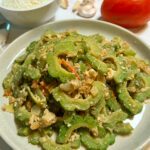Liquid seasoning is similar to soy sauce, but slightly more concentrated and umami-rich. It can elevate the savoriness in almost all dishes with just a couple drops.
I received so many DM’s and emails about what exactly liquid seasoning was when I used it in my recipes. It’s such a common staple in our pantry that I failed to realize that it’s also such a vague name.
Seasoning can refer to almost anything, really. In this context, I’ll be talking about the liquid seasoning that comes in those tiny bottles, its different brands, uses, tastes in comparison to soy sauce, etc.
If there’s one thing you get out this blog post, it’s that liquid seasoning is a flavor enhancer.
Think Worcestershire sauce in stews, and fish sauce as a secret not-so-traditional ingredient in pasta sauces. It elevates umami and savory notes in dishes. It’s an ingredient that would be a great addition to your pantry (if not already!).
Brands
Maggi
Maggi is probably one of the most popular brands of liquid seasoning. Founded in 1884 by Julius Maggi in Switzerland, this sauce can be found widespread in many, many different cultures.

In its bottled form, this seasoning is widely used in Mexico (in the form of Maggi Jugo), as well as in many parts of Southeast Asia. You can also find Maggi in the form of flavor cubes, popular in the Middle East and Africa.
Maggi is an international condiment. For the longest time, I had always thought it was strictly an Asian sauce, only to find that the sauce had different variants depending on which country it’s being marketed to (that is, the formula is cleverly altered to match that of the local’s palates).
Knorr
Knorr is fairly similar to Maggi in terms of flavor and uses. You can use them interchangeably without altering the flavor of your dishes too much.

That being said, Maggi does tend to be stronger and more umami in flavor. Knorr is less intense, slightly sweeter, and a little lighter on the palate.
If bold is what you’re looking for in your dishes, Maggi might be worth using. However, if you’re leaning towards a more balanced, nuanced taste, Knorr is for you. Ultimately, I’d recommend buying a bottle of each to see which one you prefer the most.
Golden Mountain Seasoning
This is a special type of Thai soy sauce, which is comparable to both Maggi and Knorr.

If you’re sensing a pattern, you’re entirely correct. Similar to the other liquid seasonings, Golden Mountain Seasoning is slightly more potent, rich, and savory than the standard all-purpose soy sauce.
In a pinch, I’d use it interchangeably with Maggi and Knorr if I didn’t have one of the other.
Bragg Liquid Aminos
Bragg is a gluten-free liquid seasoning, essentially marketed as an alternative to soy sauce, though I find it’s much closer to tamari in terms of its milder taste and hint of sweetness.
It’s a great alternative if you don’t typically shop at Asian markets or if you don’t have one near your area.
Difference with soy sauce
The ingredients are different
Soy sauce is predominantly made with fermented soy beans. Maggi liquid seasoning, however, is made from hydrolyzed wheat protein.
This changes the overall taste of the seasoning, differentiating it from soy sauce in terms of a deeper and more complex flavor profile.
It’s typically used sparingly
Liquid seasoning is typically used as a flavor enhancer. A couple drops or two goes a long way in sauces, dips, and soups.
I like to think of it as liquid MSG (though obviously different in tastes). Some dashes of liquid seasoning during cooking or on top of foods are one of the best ways to add even more depth and savoriness to your dishes.
It’s not typically used as a substitute for soy sauce. If you were planning to use in place of soy sauce, just be sure to reduce the amount of liquid seasoning to prevent your dish from being overly concentrated.
Liquid seasoning tastes more savory
Due to their specific recipe, liquid seasonings, while marketed as a “replacement” for soy sauce, don’t actually taste exactly like soy sauce itself.
Liquid seasonings tend to be more concentrated in flavor, saltier, and more savory than standard soy sauces. Some claim it tastes similar to a combination of soy sauce, Worcestershire, and fish sauce mixed together.
Uses
Liquid seasoning is used worldwide in a variety of dishes. The possibilities are endless as you can treat this as how you’d normally use any other flavor enhancer.
For instance, you can add it to marinades and meats to make them taste even meat-tier. Add a couple drops to soups, stir-fries, stews, noodles, and sauces to further intensify their savoriness.
You could even go as simple as adding liquid seasoning to fried rice, eggs, or even sandwiches.
Now, this whole blurb isn’t to say that liquid seasoning is the answer to fixing all your recipes. It may very well help in elevating some dishes’ tastes, but always remember to use sparingly, use your judgement, and add it to wherever makes sense to your cooking.
Here are some of the most common uses of liquid seasoning in Filipino recipes:



Sinangag (Filipino Garlic Fried Rice)

Where to purchase
Different liquid seasoning brands will have slightly different packaging from each other. Especially in various countries, you may notice that the cap color also changes (some are red, some are yellow).
Generally, Maggi and Knorr typically come in a dark brown bottle (either plastic or glass) with a yellow/green label. You can most commonly find these being sold in Asian supermarkets, though I have been seeing them popup more recently in standard grocery stores (sometimes in the “international” section).
Golden Mountain seasoning may also be found in Asian groceries, though Thai groceries may be your greatest luck in finding this one.
Bragg can be purchased in most large grocery stores. It can also be found in a health food market or a specialty grocer.
Storage
Most liquid seasonings behave much like soy sauce, meaning they don’t need to be refrigerated upon opening and are generally shelf-stable.
If unopened, keep them in a dark area that’s dry and cool.
Disclosure: Some links on this page are affiliate links, meaning that at no additional cost to you, we may receive compensation from purchases made through these links. As an Amazon Associate, I can earn from qualifying purchases.






